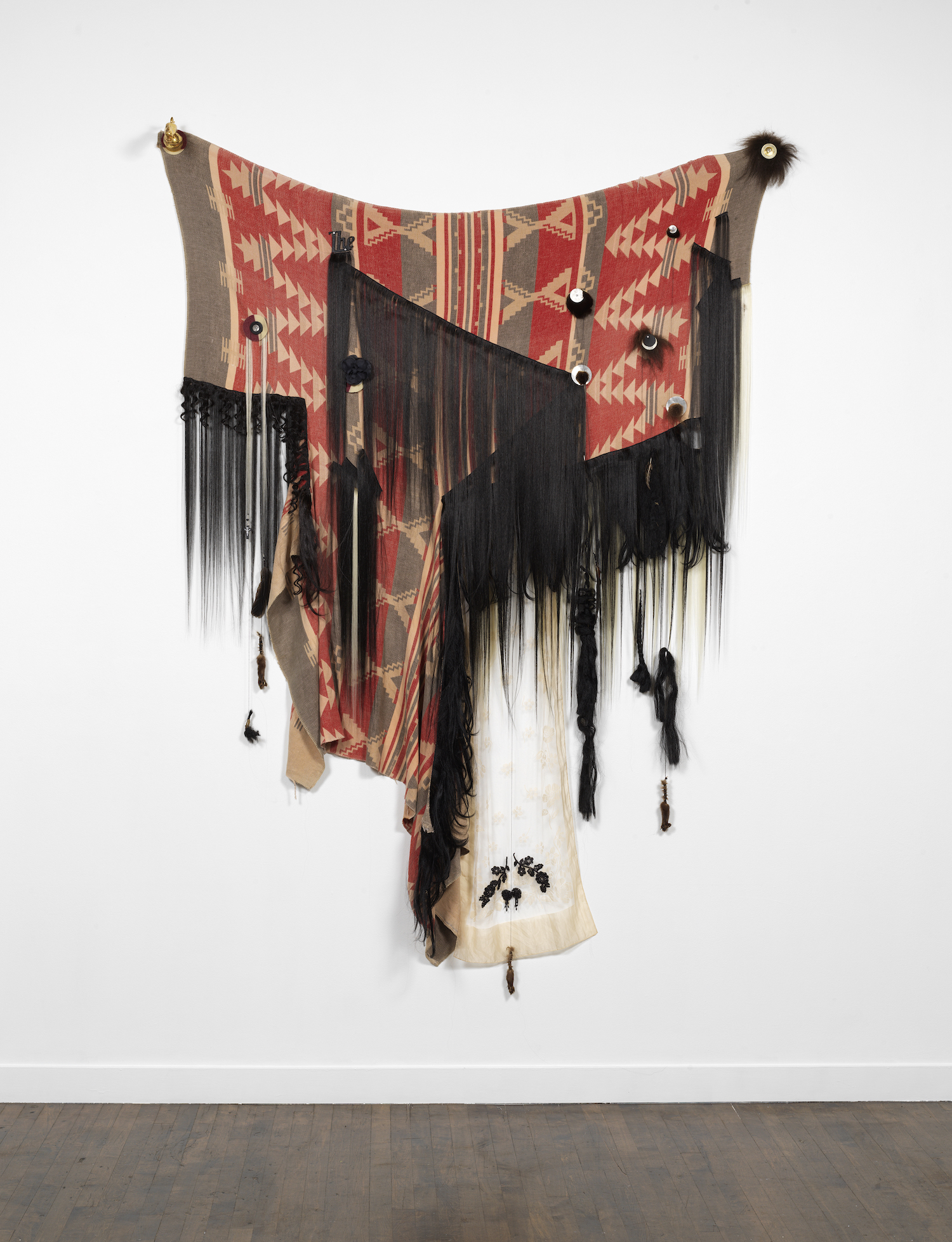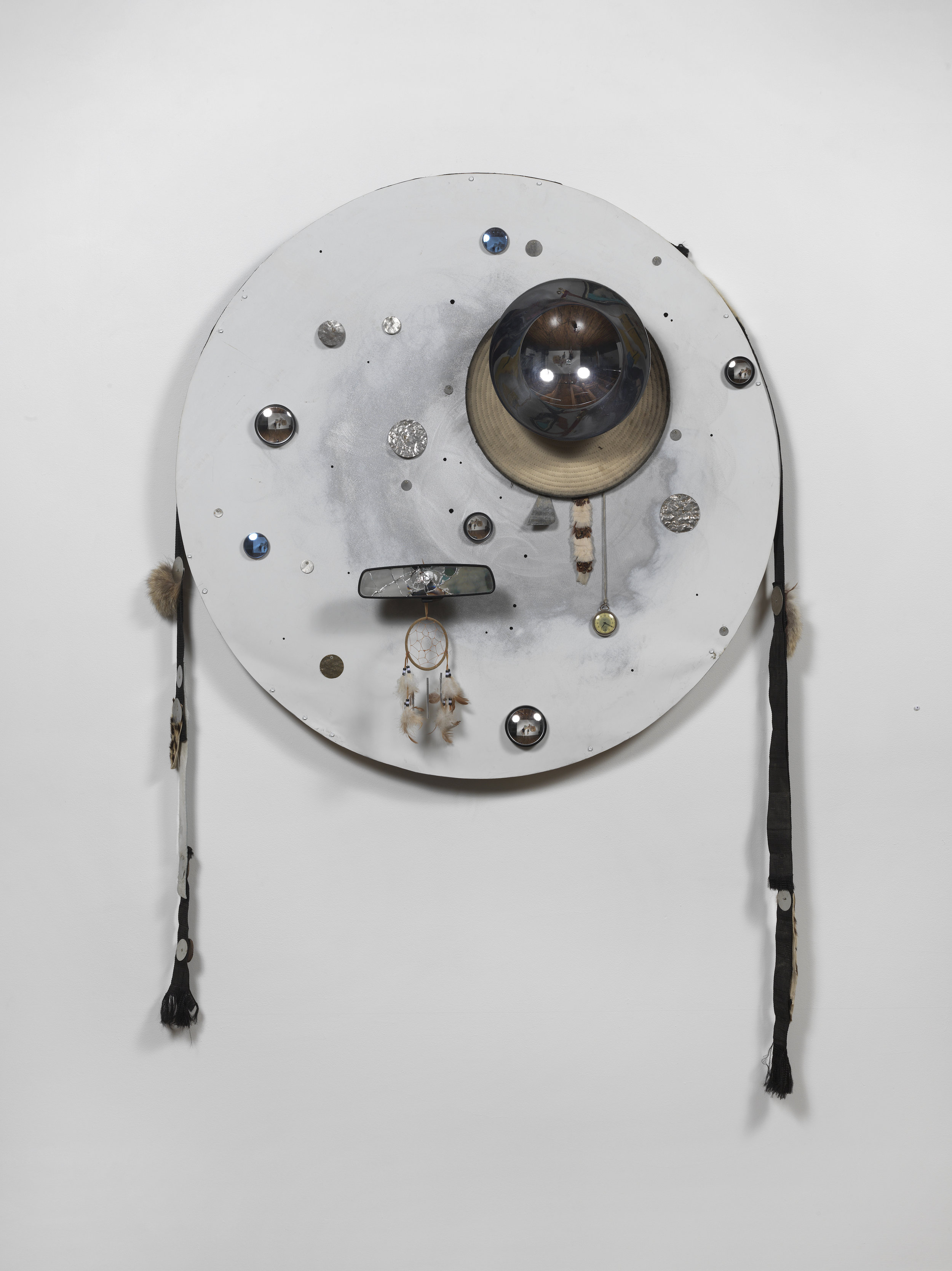"I like being conflicted." : A Conversation With Juan Angel Chavez
I first met Chicago-based artist Juan Angel Chavez during a residency at the Joan Mitchell Center in New Orleans during the summer of 2016. Recently, I had the opportunity to revisit his work at Hawthorn Contemporary in Milwaukee, where his solo exhibition Stayin' Alive is on view through September 1st. Chavez's work is powerful, profound, and poetic, and he recently took time to answer a few questions about materiality, working in the public realm, and the range of emotional responses that his work evokes. Here's our conversation:
Juan Angel Chavez, LUNAR, 2018, assemblage textile, 6 ft W x 8 ft H x 6 in D. Photo courtesy of the artist
Liz Miller: You incorporate a diverse array of materials in your sculptures and wall-based assemblages, creating poetic interludes and unexpected material juxtapositions. Many of your found materials have past lives and histories embedded in them. What is your process for selecting materials?
Juan Angel Chavez: I choose material based on their appearance only. Their APPEARANCE is not just looks to me. I look for characteristic that reflect real life situations. Textures, forms and mark in objects reveals significance about how materials are used and who used them. Their presence in the work creates a connection or an access point from where the work derives. It could be anything: Fake hair, mirrors, signage, concrete rocks, headboards, stuffed animals, etc. This is the first layer to the work.
Above: Juan Angel Chavez, Byonce, 2016, assemblage with synthetic hair, 48 in W x 36 in H x 24 in D. Below: Juan Angel Chavez, Buffalo Sade, 2016, assemblage with synthetic hair, 5 ft W x 4 ft H x 24 in D. Photos courtesy of the artist
Liz Miller: Human hair, animal hides, faux flowers, and assorted founds objects are arranged in ways that alternately make my skin crawl, make me joyous, and make me feel sad. The works suggest so many associations and emotions. What do you hope the viewer feels when they look at your work?
Juan Angel Chavez: I hope the viewer reacts exactly how you reacted. The work makes me feel the same way as it makes you feel. It is uncomfortable and joyous. I drew that work as a response to racism, social injustice and a blatant disregard for life. I spend a lot of time looking at anthropological collection of native works and I’m always drawn by their mysterious significance, but they make me wonder, about the circumstances in how they got collected. The biggest question in my mind is value of such objects. How can be so aesthetically drawn to them and then find out how tragic they are. In another way, I look at these works as elements of a contemporary elements to cabinets of curiosity. I like being conflicted.
Juan Angel Chavez, untitled, 2018. assemblage textile, 36 in W x 48 in H x 4 in D. Photo courtesy of the artist
Liz Miller: In addition to freestanding sculptures, low-relief wall works, and works on paper, you create large-scale installations that are very experiential and architectural. These sculptural installations often include interior and exterior spaces, allowing viewers to interact with the works very directly. How do you see these installations in relation to your other works?
Juan Angel Chavez: In one sense the larger installations are all about the interaction because, I consider them objects to be experiences and not collected objects. They are about the moment and similarly to how we interact with music or nostalgia. They are about trying to contain the uncontainable. I guess, they are connected in significance to materiality and structure to an object and its use. I create an interactive work, thinking of environments and the feelings that space unearths as a ceremonial structure. In other words, they connect to the other work in the act of honoring the simplicity of a complicated life.
Juan Angel Chavez, Speaker Project, 2007, mixed media assemblage, 16 ft W x 10 ft H x 24 ft D. Photo courtesy of the artist
Liz Miller: You’ve been instrumental in initiating collaborative community art initiatives in Chicago and elsewhere. How has your experience working outside of traditional exhibition venues changed your approach to working in traditional spaces?
Juan Angel Chavez: Community art initiatives/community public art and working outside of the traditional exhibition space taught me how not to fear the large scale. In the contrary, I embrace the fact that the work is going to be large and it lends itself to devise interaction. To me the large installations are a new derivative of those public art projects but without the typical conservative approaches to permanent significance.
Juan Angel Chavez, NEPTUNO, 2011, mixed media assemblage, 12 ft W x 12 ft H x 30 ft D. Photo courtesy of the artist
Liz Miller: What are you working on now, and where can we see your work in the future?
Juan Angel Chavez: Now, I’m taking a short break from making art. I’m focusing all my time for the next two months to remodel my kitchen. Soon after that I’m making a series of painting and planning a long multilayered project in Chihuahua Mexico. I’m trying to make the largest social engagement project I’ve ever done, using ceramics and adobe for materials. It is still in the planning process. So, I can’t really be more specific.
Above: Juan Angel Chavez, Plum Bread, 2016, burned plywood and plastic, 20 in W x 20 in H x 4 in D. Below: Juan Angel Chavez, Smokeless Fire, 2016, burned plywood and plastic, 36 in W x 36 in H x 4 in D. Photos courtesy of the artist
Liz Miller: When you aren’t making art, where can we find you?
Juan Angel Chavez: When I’m not making art, you will find me in the kitchen or hanging with my kids. But if I’m not being a parent you can always find me in the streets skateboarding or hunting for materials at the flea market.
Above: Juan Angel Chavez, DRIP FALLS, 2012, mixed media assemblage, 20 ft W x 6 ft x 12 in D. Below: Juan Angel Chavez, WOLFDOG, 2010, mixed media assemblage, 5 ft W x 5 ft H x 6 in D. Photos courtesy of the artist
Juan Angel Chavez is a Mexican born artist who lives and works in Chicago, Illinois. He has been active in the arts for many years. He was a leader in community engaged public art projects, that left behind a series of murals and mosaics throughout neighborhood schools and community centers. As well as, predominant works of art in libraries and transit stations that are part of the City of Chicago’s public art collection.
In 2001, he began a non-permission art installation initiative, that changed the notion of abandoned urban space and influenced other artist to claim, board up buildings and abandoned urban environments, with found objects and sculptures. He was awarded his first individual artist award for that endeavor. Since then, he has focused in the creation of large scale installations that transform galleries in museums and cultural centers into interactive environments made from found objects and discarded materials. He has exhibited in various local, national and international exhibitions and he has been nationally recognized by several prestigious awards: Richard Driehaus individual artist award, Chicago, Illinois Arts Council, Individual Artist Fellowship, Louis Comfort Tiffany award, NY, Artadia individual artist award, NY, 3ARTS award in the visual arts category, Chicago, Joan Mitchell Award for painter and sculptures, NY, and most recently the Joyce Foundation award.
Currently, he continues to push forward in creating new bodies of work and developing new ideas for large scale projects. Meanwhile, teaching as an assistant adjunct professor in the Sculpture Department of the School of The Art Institute of Chicago.










